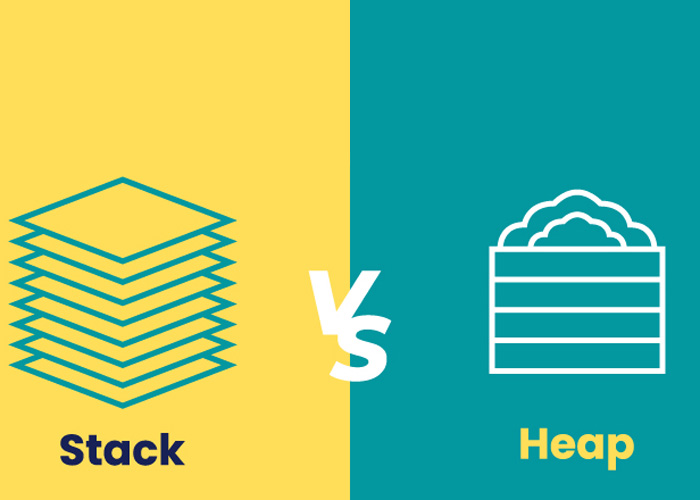Difference Between Stack and Heap in C#
In C#, memory is divided into two main types: stack and heap. Both play crucial roles in how data is managed and accessed in your programs. Understanding these memory regions helps in writing efficient and effective code.
Stack and Heap in C# with Example
1. Stack Memory
The stack is a region of memory used for static memory allocation. It handles function calls, local variables, and value types like int, float, and char. Memory is organized in a last-in, first-out (LIFO) manner. When a function is called, its data is pushed onto the stack. When the function exits, the memory is popped off.
Example:
using System;
static void Main()
{
int number = 5; // 'number' is stored on the stack
Console.WriteLine(number);
}
In this example, the variable number is a value type and is stored directly on the stack. When the Main method finishes execution, the memory used by number is automatically released.
2. Heap Memory
The heap is used for dynamic memory allocation. It handles reference types like objects and arrays. Unlike the stack, the heap is managed by the .NET garbage collector, which automatically cleans up memory that is no longer in use. This memory is more flexible but generally slower to access.
Example:
using System;
class Person
{
public string Name { get; set; }
}
static void Main()
{
Person person = new Person { Name = "Alice" }; // 'person' is allocated on the heap
Console.WriteLine(person.Name);
}
Here, Person is a reference type, and the person object is stored on the heap. The garbage collector will clean up the person object when it is no longer referenced.
Interview Questions on Stack and Heap in C#
What is the primary difference between stack and heap memory?
- Stack memory is used for static allocation and function call management, while heap memory is used for dynamic allocation and object storage.
How is memory allocated and deallocated on the stack?
- Memory on the stack is automatically managed. It is allocated when a function is called and deallocated when the function exits, following a LIFO order.
How does the garbage collector interact with heap memory?
- The .NET garbage collector automatically reclaims memory that is no longer in use on the heap, reducing the risk of memory leaks.
What is a stack overflow, and how can it be avoided?
- A stack overflow occurs when the stack memory limit is exceeded, usually due to excessive recursion or unbounded function calls. It can be avoided by ensuring that recursive calls have base cases and are not infinite.
Max Heap in C#
A max heap is a complete binary tree where the value of each node is greater than or equal to the values of its children. The largest element is at the root of the tree. Max heaps are often used in priority queues and heap sort algorithms.
Example Implementation:
using System;
using System.Collections.Generic;
class MaxHeap
{
private List<int> heap = new List<int>();
public void Insert(int value)
{
heap.Add(value);
HeapifyUp(heap.Count - 1);
}
private void HeapifyUp(int index)
{
while (index > 0)
{
int parentIndex = (index - 1) / 2;
if (heap[index] > heap[parentIndex])
{
Swap(index, parentIndex);
index = parentIndex;
}
else
{
break;
}
}
}
private void Swap(int i, int j)
{
int temp = heap[i];
heap[i] = heap[j];
heap[j] = temp;
}
}
static void Main()
{
MaxHeap maxHeap = new MaxHeap();
maxHeap.Insert(10);
maxHeap.Insert(20);
maxHeap.Insert(15);
// Additional code to print heap elements or perform operations
}
Min Heap in C#
A min heap is a complete binary tree where the value of each node is less than or equal to the values of its children. The smallest element is at the root. Min heaps are used in algorithms such as Dijkstra's shortest path.
Example Implementation:
using System;
using System.Collections.Generic;
class MinHeap
{
private List<int> heap = new List<int>();
public void Insert(int value)
{
heap.Add(value);
HeapifyUp(heap.Count - 1);
}
private void HeapifyUp(int index)
{
while (index > 0)
{
int parentIndex = (index - 1) / 2;
if (heap[index] < heap[parentIndex])
{
Swap(index, parentIndex);
index = parentIndex;
}
else
{
break;
}
}
}
private void Swap(int i, int j)
{
int temp = heap[i];
heap[i] = heap[j];
heap[j] = temp;
}
}
static void Main()
{
MinHeap minHeap = new MinHeap();
minHeap.Insert(10);
minHeap.Insert(5);
minHeap.Insert(15);
// Additional code to print heap elements or perform operations
}
C# Heap Class
C# does not include a built-in heap class in the standard library, but heaps can be implemented using collections like List<T>. You can create custom heap classes, such as the MaxHeap and MinHeap examples shown above.
C# Heap Collection
Although C# does not provide a direct heap collection, you can implement heap-like structures using existing .NET collections or third-party libraries. For instance, the PriorityQueue<TElement, TPriority> class introduced in .NET 7 provides priority queue functionality based on heap principles.
C# Heap Data Structure
The heap data structure is a binary tree where each node follows a specific order property: in a max heap, each parent is greater than its children; in a min heap, each parent is smaller. This structure supports efficient insertion, deletion, and retrieval of the maximum or minimum element.
C# Heap Priority Queue
A priority queue is often implemented using a heap. It allows for efficient retrieval of elements based on their priority. In .NET 7, the PriorityQueue<TElement, TPriority> class provides this functionality with heap-based performance.
Example:
using System;
using System.Collections.Generic;
static void Main()
{
var priorityQueue = new PriorityQueue<string, int>();
priorityQueue.Enqueue("Task1", 2);
priorityQueue.Enqueue("Task2", 1);
priorityQueue.Enqueue("Task3", 3);
while (priorityQueue.Count > 0)
{
var task = priorityQueue.Dequeue();
Console.WriteLine(task);
}
}
In this example, tasks are processed based on their priority, with the highest priority (smallest number) being processed first.





